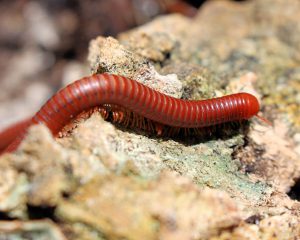
We receive many calls from homeowners having issues with worm-like, several inch long critters that turn out to be millipedes. Millipede populations periodically congregate as they migrate to other sites – maybe your lanai or garage. In this millipede story, there is mostly good news to report.
Millipedes are not to be confused with predatory centipedes but are harmless arthropods which consume organic matter. Each segment of their body contains four legs which work in unison to propel these creatures forward. They are practically everywhere outside in mulch, leaf litter and forest floors. Compost heaps are common environments for these active munchers. They are essential organisms which help breakdown large amounts of organic matter into smaller particles to the benefit of the soil.
So, we know that they are beneficial and harmless, but they can also be a nuisance. During certain months, millipedes emerge in large numbers. Those who study millipedes do not know why, but at times they migrate in mass. It may be that the rains of summer cause them to move to higher ground. In dryer times, migration could also be triggered from lack of moisture as they search for humid environments. And once they move to higher ground, they climb up walls, enter garages and lanais. I have seen cases where they come in through small gaps under doors, climb up the walls and then head for the light fixtures where they eventually die. They cannot tolerate a dry environment for long. Unfortunately, not many predators like to eat millipedes as they produce irritating chemicals which ward off would-be natural enemies.

Now throw into the mix two newer invasive millipedes – the yellow-banded and the rusty millipede – and you could have a formula for a millipede “apocalypse” in some areas. So, what are we to do with these harmless detritus eaters? Culturally, you can look at mechanical techniques for exclusion. Check doors for gaps and seal up any opening that may allow entry. There are a number of perimeter pesticides that have millipedes on the label which can be used when applied around the outside of the house. This will be a temporary measure and may have to be retreated according to the label directions.
Millipedes have more good characteristics than bad. Yes, they can be a nuisance, but count your blessings – they do not bite, sting, transmit disease, damage wood, food or clothing! For more information on all types of household pests found in our area, you can also call the Master Gardener Volunteer Helpdesk on Mondays, Wednesdays, and Fridays from 1 to 4 pm at 764-4340 for gardening help and insight into their role as an Extension volunteer. Ralph E. Mitchell is the Director/Horticulture Agent for UF/IFAS Extension – Charlotte County. He can be reached at 941-764-4344 or ralph.mitchell@charlottecountyfl.gov. Connect with us on social media. Like us on Facebook @CharlotteCountyExtension and follow us on Instagram @ifascharco .
Resources:
Koehler P. G., Pereira, R. M. & Allen, R. A. (2022) Pillbugs, Sowbugs, Centipedes, Millipedes, and Earwigs. The University of Florida Extension Service, IFAS.
Schall, B. (2015) Millipede Invasion! The University of Florida Extension Service, IFAS – Palm Beach County
What’s That Bug? (2010) Rusty Millipede. https://www.whatsthatbug.com/2010/11/10/rusty-millipede/
Shearer, L. (2018) Collier homeowners deal with millipede invasion. Naples Daily News.
Source: UF/IFAS Pest Alert



